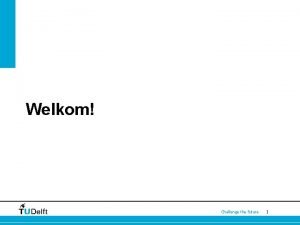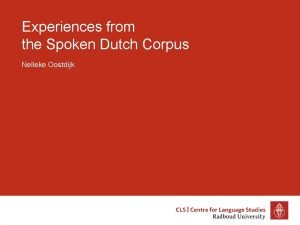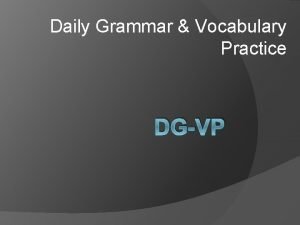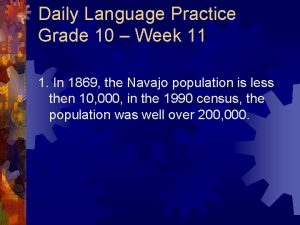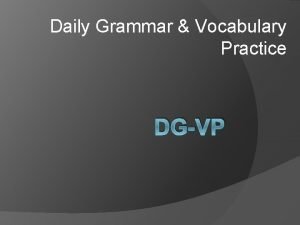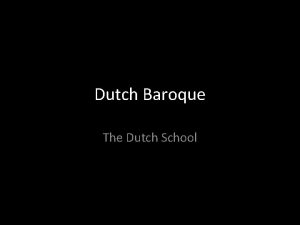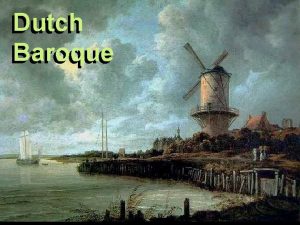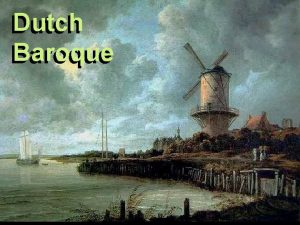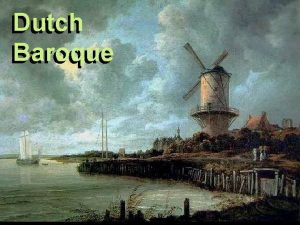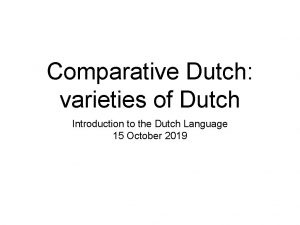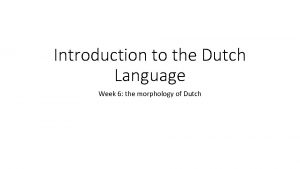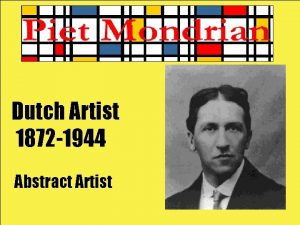Introduction to the Dutch Language Week 7 Dutch
















- Slides: 16

Introduction to the Dutch Language Week 7: Dutch word order

Today 1. Presentation 2. Word order in Dutch 3. Dutch practice

Word order in Dutch • Preliminary remark: Word order is very important and quite fixed in Dutch due to its lack of flexion. • Some basic terms. • Dutch is a V 2 / SOV language. • Dutch is generally a head-final language. • Basic word order rules (that aren’t actually rules): adverbial phrases; direct and indirect objects. • The importance of theme/comment structure for word order. • Why the Dutch language is bipolar. • Behold the wonder that is the syntax tree.

Word order: some basic terms • Subject, Object, Verb: a typology of languages. • Head-initial vs. Head-final: an alternative typology of languages: is the main constituent of a phrase at its end or at its start? • Main clauses and sub-clauses: sub-clauses fulfil a grammatical function in another (main) clause; main clauses don’t. Sentences that contain sub-clauses are ‘complex’ sentences. • Sentence, clause, phrase. • Phrases: categorical phrases (Noun, Verb, Adjective, Preposition, Determiner) and functional phrases (Inflection).

Dutch is a V 2 / SOV language • Dutch basic word order is SOV: the subject comes first, then the object(s), and the verb is final. • However, in main clauses, the conjugated verb MUST be in the second (grammatical, functional) position. (Apparent) exceptions: yes/no questions and imperative phrases and certain (archaic) conjunctive phrases. • *Ik koekjes eten ga, but: Ik ga koekjes eten, Ik zeg dat ik koekjes eten ga (/ga eten).

Dutch is generally a headfinal language • In Dutch, the main constituent of a phrase tends to come last: ‘de mooie man’, a noun phrase, has ‘man’, the noun, at the end. (Although some linguists would call this a ‘determiner’ phrase, which would of course ruin this typology. Linguistics often looks more science-y than it actually is. But I digress. ) Also: ‘koekie eten’ (eat cookie) is a verb phrase, again with the verb at the end. (Note the different order in English; also, note that phrases stack: this verb phrase contains a noun phrase (‘koekie’)).

Basic word order rules (that aren’t actually rules) • For adverbial phrases: time, manner, place: ‘Ik ging gisteren met mijn moeder op de fiets naar Amsterdam. ’ • For objects: indirect objects first, direct objects second: ik gaf de man het boek. Or: toen de man aangewezen had, was alles de man duidelijk geworden. • An interesting quirk: ambiguous preposition of place/direction (‘in’) + [place] == place (‘in het huis’), [place] + ambiguous preposition of place/direction == direction (‘het huis in’). • BUT

The importance of theme/comment structure for word order (and Dutch grammar in general) • (The theme/rheme distinction is, I am obliged to remark, a Prague invention. ) • Dutch (and Czech, if I’m not mistaken) sentences tend to start with known information and then ‘comment’ upon that known information with new information. • Short deictic words therefore tend to congregate at the start of the sentence, while longer, more specific words/phrases go at the end. • So: ‘Ik wil twee boeken’ BUT ‘Ik wil ER twee’; • Also: free placement of adverbial phrases including propositions at the end of the sentence (for emphasis): ‘Ik ben gisteren met mijn moeder op de fiets naar Amsterdam gegaan’ vs. ‘Ik ben gisteren op de fiets naar Amsterdam gegaan met mijn moeder’). • Also: ‘Ik heb hem het boek gegeven’ BUT ‘Ik heb HET hem gisteren gegeven’. • (Compare Czech, which regularly puts the reflexive pronoun in the second position in the sentence for, I imagine – but don’t actually know – similar reasons. )

Why the Dutch language is bipolar • The two-pole theory of Dutch sentence structure: [Run-up] 1 st position, first Verbal Pole, middle, second verbal pole, last position. • Anything can be in first position (usually (part of) theme, but (confusingly) in cases of ‘paradoxical emphasis’ (part of) the comment, too, can be found here). • First verbal pole: reserved for conjugated verbs and subordinate conjunctions. • Middle: anything can go here, except of course for the above-mentioned verbs and subordinate conjunctions, and, as we’ll see, the so-called ‘verbal rest’. • The second verbal pole: this is where the verbal rest goes, including past or passive participles, infinite verbs and the separable parts of separable verbs. (order: 1) separable parts of separable verbs, 2)[participle], 3) auxiliary verb of time, 4) modal verbs, 5) main verb, 6)[participle]. • The last position: reserved for adverbial phrases with prepositions. You can fit a couple here.

Behold the wonder that is the syntax tree • Source: https: //www. ucl. ac. uk/dutchstudies/an/SP_LINKS_UCL_P OPUP/SPs_english/linguistics/syntax_verb. html






 Week by week plans for documenting children's development
Week by week plans for documenting children's development Welkom language
Welkom language Lemmatization pronunciation
Lemmatization pronunciation 5-a-day language review week 9 answer key
5-a-day language review week 9 answer key Daily language review week 18 answers
Daily language review week 18 answers Did you see big
Did you see big Dgp week 14
Dgp week 14 Daily language practice
Daily language practice Dgp sentences 7th grade answers
Dgp sentences 7th grade answers Hình ảnh bộ gõ cơ thể búng tay
Hình ảnh bộ gõ cơ thể búng tay Ng-html
Ng-html Bổ thể
Bổ thể Tỉ lệ cơ thể trẻ em
Tỉ lệ cơ thể trẻ em Gấu đi như thế nào
Gấu đi như thế nào Tư thế worm breton là gì
Tư thế worm breton là gì Alleluia hat len nguoi oi
Alleluia hat len nguoi oi Các môn thể thao bắt đầu bằng từ đua
Các môn thể thao bắt đầu bằng từ đua

